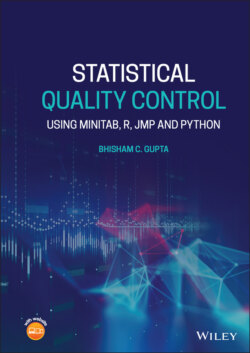Читать книгу Statistical Quality Control - Bhisham C. Gupta - Страница 51
2.4.1 The Basic Seven Tools and the New Seven Tools
ОглавлениеSix Sigma practitioners also leverage the Basic Seven and New Seven Tools. The Basic Seven tools were first brought into focus by Kaoru Ishikawa, a professor of engineering at Tokyo University and the father of “Quality Circles.” These tools can be used to collect and analyze data in the Measure, Analyze, Improve, and Control phases of a Six Sigma project:
1 Cause‐and‐effect diagram (also known as Ishikawa or fishbone diagram): A visual tool that identifies potential causes of a problem and sorts ideas into useful categories.
2 Check sheet: A structured, prepared form for collecting and analyzing the frequency of occurrences of various events.
3 Control chart: A graph used to study how a process changes over time. Comparing current data to historical control limits leads to conclusions about whether the process variation is consistent (in control) or unpredictable (out of control due to some special causes of variation).
4 Histogram: A bar chart that shows the shape of a data set using its frequency distribution, or how often each value occurs in a data set.
5 Pareto chart: A bar graph that shows the frequency of occurrence of events in descending order. The chart helps the team focus on the main drivers of a problem.
6 Scatter diagram: An X‐Y plot that shows the relationship between two quantitative variables that are measured in pairs.
7 Stratification: A technique that separates data gathered from a variety of sources so that patterns can be seen.
All of these tools are discussed at length in the next three chapters.
In 1976, the Union of Japanese Scientists and Engineers (JUSE) saw the need for tools to promote innovation, communicate information, and successfully plan major projects. A team researched and developed the New 7 Tools, often called the Seven Management Tools:
1 Affinity diagram: A visual tool that allows a team to organize a large number of ideas, opinions, or issues into their natural relationship groupings.
2 Arrow diagram: A graphical tool that shows the required order of tasks in a project or process, the best schedule for the entire project, and potential scheduling and resource problems and their solutions.
3 Interrelationship diagram: A visual tool that shows cause‐and‐effect relationships and helps analyze the natural links between various aspects of a complex situation.
4 Matrix diagram: A tool that shows the relationship between two, three, or four groups and can give information about the relationship, such as its strength and the roles played by various individuals or measurements.
5 Prioritization matrix: A decision tool that rates various options based on predetermined criteria.
6 Process decision program chart: A risk analysis tool that systematically identifies what might go wrong in a plan under development.
7 Tree diagram: A visual tool that breaks broad categories down into finer and finer levels of detail, helping to move step‐by‐step thinking from generalities to specifics.
